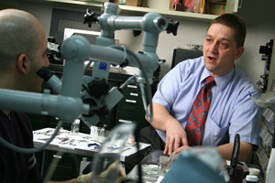Improving Cochlear Implants
 While hearing-impaired individuals with cochlear implants may not see the light, they may hear better for it if studies exploring the use of lasers to stimulate auditory nerve fibers prove sound. Feinberg School of Medicine researcher Claus-Peter Richter, MD, PhD (pictured far right), and his associates are investigating the power and precision of low energy pulsed infrared light—versus electrodes—to develop more effective cochlear implants.
While hearing-impaired individuals with cochlear implants may not see the light, they may hear better for it if studies exploring the use of lasers to stimulate auditory nerve fibers prove sound. Feinberg School of Medicine researcher Claus-Peter Richter, MD, PhD (pictured far right), and his associates are investigating the power and precision of low energy pulsed infrared light—versus electrodes—to develop more effective cochlear implants.
“Today’s technology works well if the environment is quiet with no background noise and the communication is one on one,” explains Dr. Richter, assistant professor of otolaryngology—head and neck surgery. “However, once you get to the ‘party effect’ with a lot of noise and multiple people talking, then you start challenging the cochlear implant user. An airport, for example, is the worst case scenario. It is difficult enough for individuals with normal hearing to focus on what they need or want to hear in that type of setting.”
Roughly 100,000 people worldwide rely on electronic-driven cochlear implants to help them process sound and understand speech, according to the National Institute on Deafness and Other Communication Disorders (NIDCD). Current technology involves surgically placing electrodes inside the cochlea located in the inner ear. The implant converts sound from the environment into electrical signals which are transmitted by the electrodes to the nerve fibers of the auditory system. These neurons then carry information to the brain that allows hearing impaired individuals to make out sounds, words, and running speech. While considered a “great biomedical success story,” today’s cochlear implants have their limitations due, in part, to the broad spread of electrical current introduced by the electrodes. Too many messages—especially mixed ones—essentially confuse the brain.
Explains Dr. Richter, “Overlapping stimulation of neurons by the electrodes confuses the information transfer to the brain, making it difficult to pick out sounds or understand music.”
Since 2004 Dr. Richter has been working with Joseph T. Walsh Jr., PhD, professor of biomedical engineering at Northwestern, to study the influence of pulsed laser radiation on neuronal activity in the auditory system. Demonstrating that infrared light can effectively serve as an auditory neurointerface and be safely applied for up to six hours to localized areas without overheating or “cooking” tissue in gerbils, Dr. Richter’s team received a five-year $1.68 million grant from the NIDCD in September to advance their research.
“What we are determining now are the required laser parameters—optimal wavelengths, pulse lengths, and pulse frequencies—to build a cochlear implant based on laser technology,” says Dr. Richter. “The next phase will be to test such an implant in a larger animal model.”
Advantages of light stimulation include increasing the ability to precisely target nerve cells in the cochlea and expanding the inner ear’s “bandwidth” for incoming signals, thus improving information about sounds in the environment transmitted to the brain, according to Dr. Richter. Laser technology also takes a “hands off” approach to the stimulation of nerve fibers.
“Electrodes must always touch tissue for the neurointerface to occur,” Dr. Richter explains. “With light, there is no need to physically touch the nerve cells, which could lead to potential damage or alteration of the tissues themselves.”
Dr. Richter and his colleagues plan to develop a hybrid implant that provides both optical and electrical simulation for clinical testing in humans. Such a dual-action cochlear implant would offer a back up in the event one of the methods were to fail. Says Dr. Richter, “Our hope, in the not too distant future, is that in challenging situations deaf individuals will be able to regain closer to normal hearing ability by using this laser technology in their cochlear implant.”






